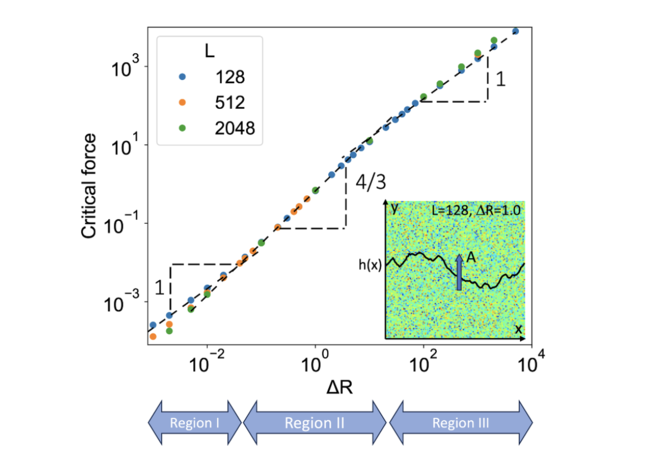 The yield stress of random solid solutions is a classic theme in physical metallurgy that currently attracts a renewed interest in connection to high entropy alloys. Here, we revisit this subject using a minimal dislocation dynamics model, where a dislocation is represented as an elastic line with a constant line tension embedded in the stochastic stress field of the solutes. Our exploration of size effects reveals that the so-called Larkin length (Lc) is not a length scale over which a dislocation can be geometrically decomposed. Instead, Lc is a crossover length scale marking a transition in dislocation behavior identifiable in at least three properties: (1) below Lc, the dislocation is close to straight, aligned in a single energy valley, while above Lc, it roughens and traverses several valleys; (2) the yield stress exhibits pronounced size-dependence below Lc but becomes size-independent above Lc; (3) the power-spectral density of the dislocation shape changes scaling at a critical wavelength directly proportional to Lc. We show that for white and correlated stress noises, Lc and the thermodynamic limit of the yield stress can be predicted using Larkin’s model, where the noise dependence in the glide direction is neglected. Moreover, we show that our analysis is relevant beyond the minimal line tension model by comparison with atomic-scale simulations. Finally, our work suggests a practical approach for predicting yield stresses in atomistic models of random solid solutions, which only involves small-scale atomistic simulations below Lc.
The yield stress of random solid solutions is a classic theme in physical metallurgy that currently attracts a renewed interest in connection to high entropy alloys. Here, we revisit this subject using a minimal dislocation dynamics model, where a dislocation is represented as an elastic line with a constant line tension embedded in the stochastic stress field of the solutes. Our exploration of size effects reveals that the so-called Larkin length (Lc) is not a length scale over which a dislocation can be geometrically decomposed. Instead, Lc is a crossover length scale marking a transition in dislocation behavior identifiable in at least three properties: (1) below Lc, the dislocation is close to straight, aligned in a single energy valley, while above Lc, it roughens and traverses several valleys; (2) the yield stress exhibits pronounced size-dependence below Lc but becomes size-independent above Lc; (3) the power-spectral density of the dislocation shape changes scaling at a critical wavelength directly proportional to Lc. We show that for white and correlated stress noises, Lc and the thermodynamic limit of the yield stress can be predicted using Larkin’s model, where the noise dependence in the glide direction is neglected. Moreover, we show that our analysis is relevant beyond the minimal line tension model by comparison with atomic-scale simulations. Finally, our work suggests a practical approach for predicting yield stresses in atomistic models of random solid solutions, which only involves small-scale atomistic simulations below Lc.

